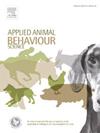从自然到培养——基因和环境如何相互作用来塑造行为
IF 2.2
2区 农林科学
Q1 AGRICULTURE, DAIRY & ANIMAL SCIENCE
引用次数: 0
摘要
先天与后天的问题在20世纪上半叶引起了热烈的讨论,但长期以来一直得到解决:所有动物的行为都是遗传和环境因素共同作用的结果。在过去的几十年里,生物学获得了前所未有的新工具来分析行为变异的遗传基础。在本文中,举例说明了分析如何从遗传力的总体估计转向详细的遗传作图,并对导致行为差异的遗传机制有了新的见解。与此同时,对环境和经验影响的研究在很大程度上是与基因分析分开进行的。然而,我们现在处于一个位置,我们可以开始了解遗传和环境如何相互作用的细节,主要是通过表观遗传机制。举例说明不同的经历如何引起表观遗传修饰,进而调节基因组的表达。此外,表观遗传修饰可以遗传,甚至可能影响与引起表观遗传变化的经历相关的突变,从而为环境驱动的进化提供了可能。最后,给出了未来研究领域的例子,这些研究领域可能会进一步促进我们对自然和培养如何相互作用的理解,特别是游戏行为和肠-脑轴如何影响(以及受)表观基因组的影响。这篇论文的结论是,解开基因组、环境和表观基因组之间复杂的相互作用,将使我们对形成行为的自然-培育相互作用有一个相当全面的了解。本文章由计算机程序翻译,如有差异,请以英文原文为准。
From nature to nurture – How genes and environment interact to shape behaviour
The question of nature vs nurture caused animated discussions during the first half of the 20th century but is since long resolved: all animal behaviour is a result of both genetic and environmental factors. In the last couple of decades, biology has got access to new and unprecedented tools for analysing the genetic underpinnings of behaviour variation. In this paper, examples are given on how analyses have moved from gross estimates of heritability to detailed genetic mapping, with new insights into the genetic mechanisms causing differences in behaviour. At the same time, studies of the effects of environment and experience largely have been running in isolation from the genetic analysis. However, we are now in a position where we can start to understand the details of how genetics and environment interact, primarily through epigenetic mechanisms. Examples are given of how different experiences cause epigenetic modifications, that in turn regulate the expression of the genome. Furthermore, epigenetic modifications can be inherited and even possibly affect mutations specifically related to the experience causing the epigenetic change, opening the possibility for environmentally driven evolution. Lastly, examples are given of future research fields that may further advance our understanding of how nature and nurture interact, specifically how play behaviour and the gut-brain axis may affect (and be affected by) the epigenome. The paper concludes that unravelling the complex interaction between genome, environment and epigenome will give rise to a considerably more comprehensive picture of the nature-nurture interactions in shaping behaviour.
求助全文
通过发布文献求助,成功后即可免费获取论文全文。
去求助
来源期刊

Applied Animal Behaviour Science
农林科学-行为科学
CiteScore
4.40
自引率
21.70%
发文量
191
审稿时长
18.1 weeks
期刊介绍:
This journal publishes relevant information on the behaviour of domesticated and utilized animals.
Topics covered include:
-Behaviour of farm, zoo and laboratory animals in relation to animal management and welfare
-Behaviour of companion animals in relation to behavioural problems, for example, in relation to the training of dogs for different purposes, in relation to behavioural problems
-Studies of the behaviour of wild animals when these studies are relevant from an applied perspective, for example in relation to wildlife management, pest management or nature conservation
-Methodological studies within relevant fields
The principal subjects are farm, companion and laboratory animals, including, of course, poultry. The journal also deals with the following animal subjects:
-Those involved in any farming system, e.g. deer, rabbits and fur-bearing animals
-Those in ANY form of confinement, e.g. zoos, safari parks and other forms of display
-Feral animals, and any animal species which impinge on farming operations, e.g. as causes of loss or damage
-Species used for hunting, recreation etc. may also be considered as acceptable subjects in some instances
-Laboratory animals, if the material relates to their behavioural requirements
 求助内容:
求助内容: 应助结果提醒方式:
应助结果提醒方式:


